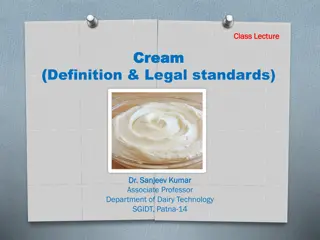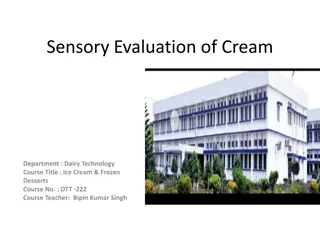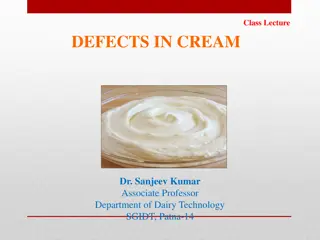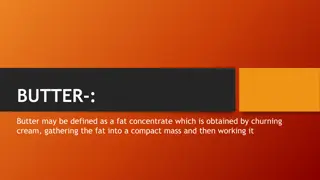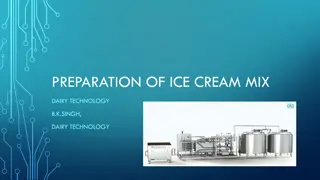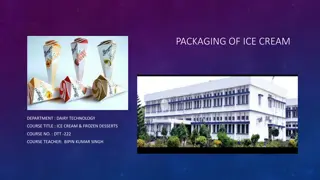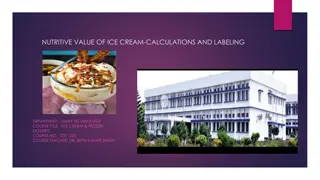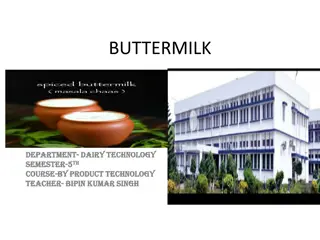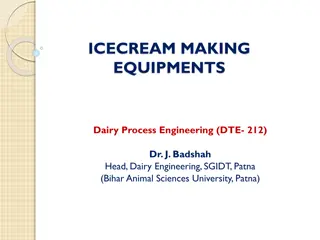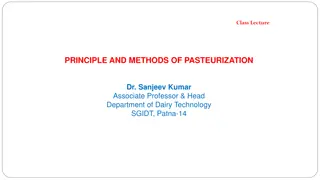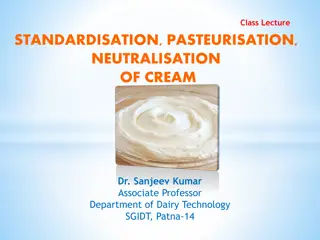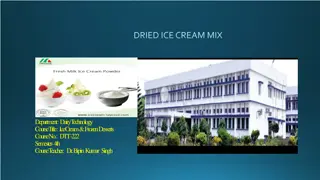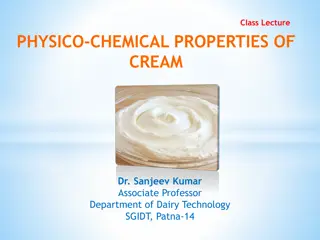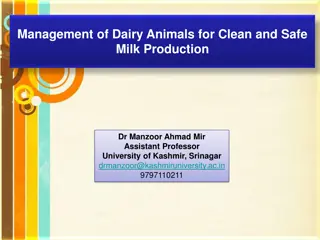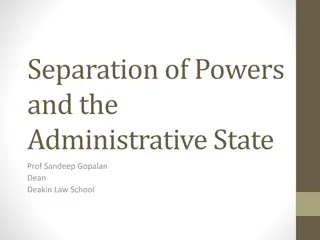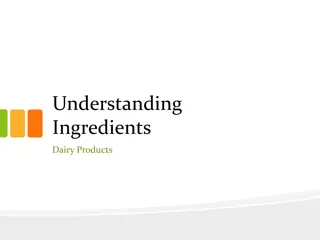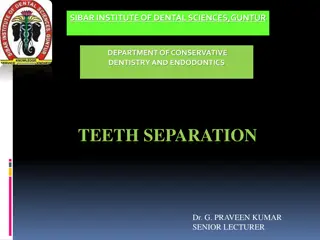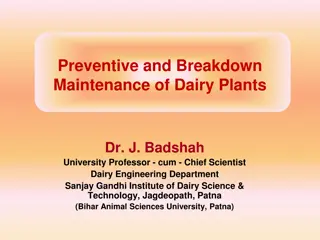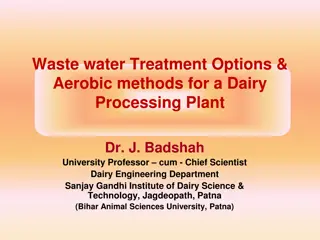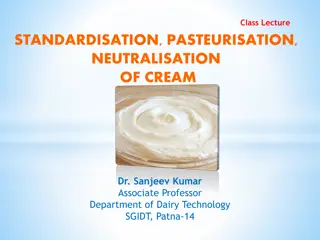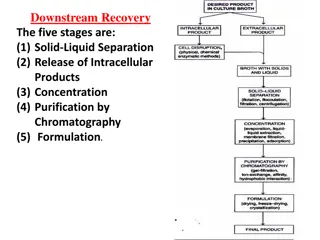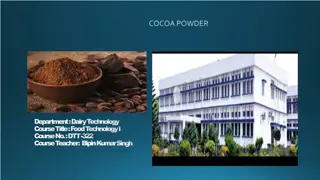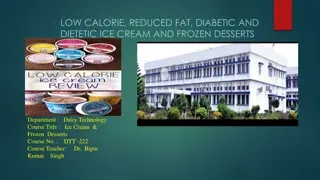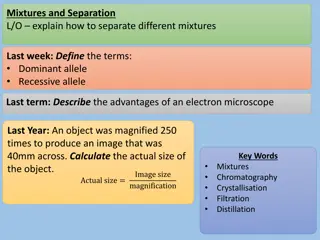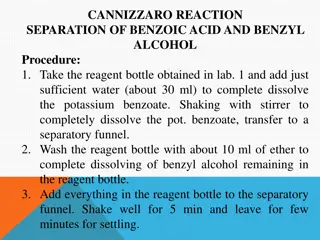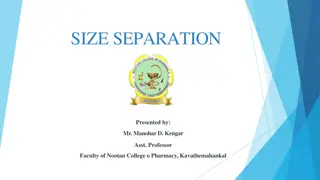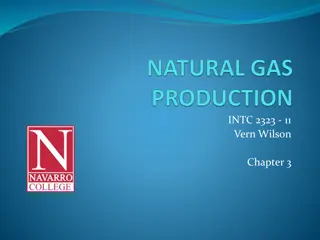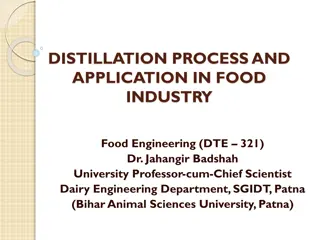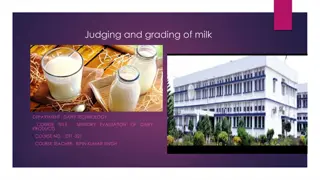Cream Separation Methods and Principles in Dairy Technology
Cream separation in dairy technology involves various methods such as centrifugal and gravity methods. The purpose is to obtain fat-reduced or fat-free milk, concentrate milk fat, standardize fat content, and recover fat. The separation is based on the principle that milk fat is lighter than skim milk. Factors affecting the rate of rise in the gravity method include clumping, temperature, adhesives, and size of fat globules. Centrifugal method involves subjecting milk to centrifugal force to separate skim milk and fat.
Download Presentation

Please find below an Image/Link to download the presentation.
The content on the website is provided AS IS for your information and personal use only. It may not be sold, licensed, or shared on other websites without obtaining consent from the author. Download presentation by click this link. If you encounter any issues during the download, it is possible that the publisher has removed the file from their server.
E N D
Presentation Transcript
Class Lecture Class Lecture CREAM SEPARATION CREAM SEPARATION Dr. Dr. Sanjeev Sanjeev Kumar Associate Professor Department of Dairy Technology SGIDT, Patna-14 Kumar
PURPOSE OF CREAM SEPARATION: To obtain a fat-reduced or fat-free milk To concentrate milk fat for the production of high-fat products To standardize the fat content of milk To recover fat from milk
PRINCIPLE OF SEPARATION OF CREAM Based on the fact that milk fat is lighter than skim milk portion. At 16 C (60 F) , the average density of milk fat is 0.93 and skim milk 1.036.
METHODS OF CREAM SEPARATION CENTRIFUGAL METHOD GRAVITY METHOD
COMPARISON OF METHODS PARTICULARS GRAVITY METHOD GRAVITATIONAL CENTRIFUGAL METHOD CENTRIFUGAL NATURE OF FORCE CAUSING SEPARATION SPEED OF SEPARATION EXTREMELY SLOW PRACTICALLY INSTANTANEOUS DIRECTION OF MOVEMENT PARTICLES VERTICAL HORIZONTAL BACTERIOLOGICAL QUALITY OF PARTICLES LOW HIGH FAT % OF CREAM 10-25 18-25(can be controlled) FAT % OF SM 0.2 or above 0.1 or below
GRAVITY METHOD Fat has a tendency to rise , when milk is allowed to stand for sometime. The velocity (V), or rate at which the fat globules rise, is given by the following equation, derived from stroke s law: V= 2g (ds df) r 9 Where, g is acceleration due to gravity, ds is density of skim milk, df is density of fat, r is radius of fat globule, is viscosity of skim milk.
CLUMPING (increase in r , increases velocity) TEMPERATURE (increase in temperature, increases velocity) ADDITION OF ADHESIVES (increases the rate of fat globule size) SIZE OF FAT GLOBULES( in globule size, es velocity) FACTORS AFFECTING THE RATE OF RISE OF CREAM IN GRAVITY METHOD
CENTRIFUGAL METHOD Milk is fed to centrifugal cream separator, where it is subjected to centrifugal force in such a way that skim milk is forced to the periphery while the fat portion towards the centre. Stroke s law applied to centrifugal separation is as follows: V= K.R.N (ds df) r Where, ds is density of skim milk, df is density of fat, r is radius of fat globule, is viscosity of skim milk, N is r.p.m., R is bowl radius K is constant
FACTORS AFFECTING FAT % OF CREAM In POSITION OF CREAM SCREW (CREAM SCREW IN OR SKIM MILK SCREW OUT , HIGHER FAT % IN CREAM AND VICE VERSA) AMOUNT OF SKIM MILK OR WATER ADDED TO FLUSH THE BOWL, es fat%in cream In In In In TEMPER ATURE OF MILK, es fat% in cream SPEED OF BOWL, es fat% in cream RATE OF MILK INFLOW, es fat% in cream FAT % IN MILK, es fat% in cream
FACTORS AFFECTING FAT LOSS IN SKIM MILK 1) in Temperature of milk, es losses. 2) in Speed of bowl, es losses. 3) in rate of milk inflow, es losses 4)Position of the cream screw (fat separation of more than 50%, more losses) 5) Mechanical condition of the machine ( unsatisfactory condition, more losses)
6) Size of fat globules (Greater the no. of fat globules of less than 2 micron size, higher losses) 7) in Degree and temperature at which milk is separation, es losses. 8) in Presence of air in milk, es losses. 9) in Acidity of milk, es losses. agitated before
YIELD OF CREAM (kg): C= M*(fm-fs) (fc-fs) YIELD OF SKIM MILK(kg): S= M*(fc-fm) (fc-fs) Where, C is weight of cream (kg), S is weight of skim milk (kg), M is weight of milk (kg), fc is fat % of cream , fm is fat % of milk, fs is fat % of skim milk


